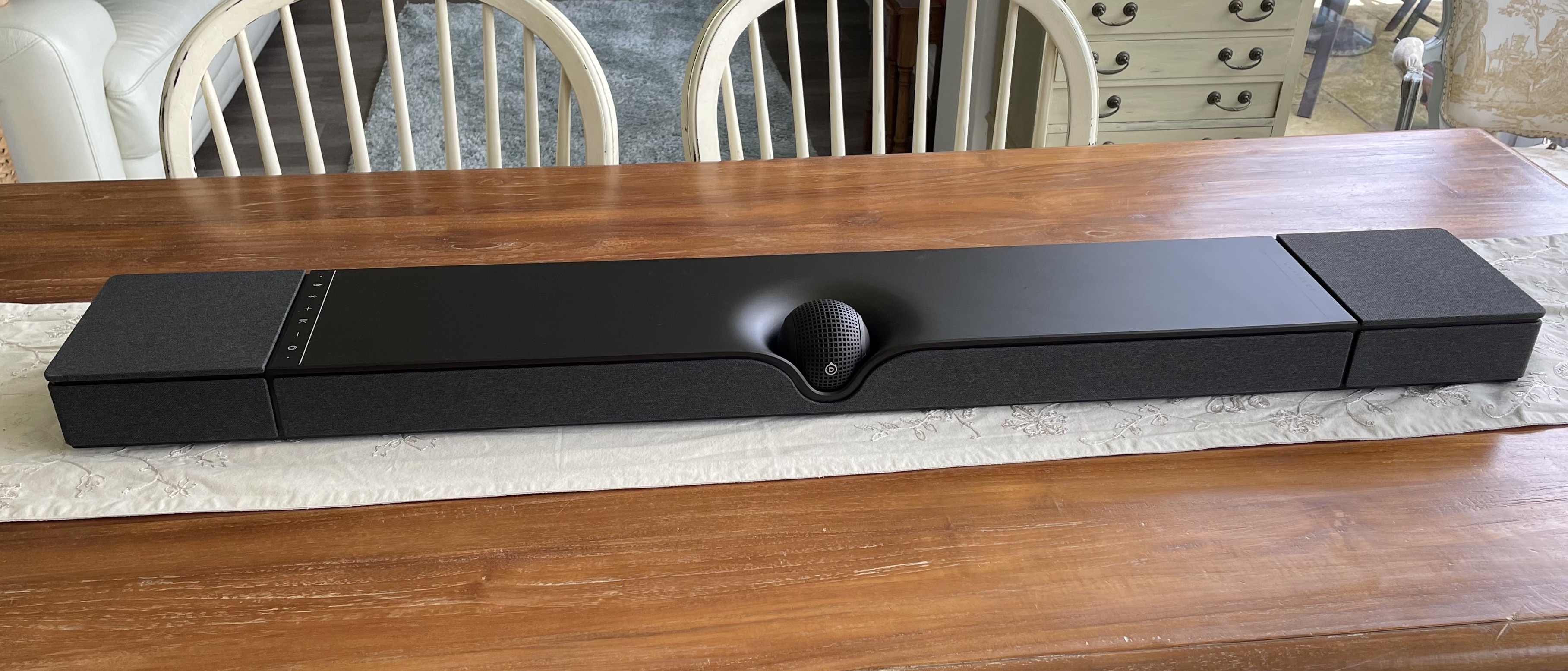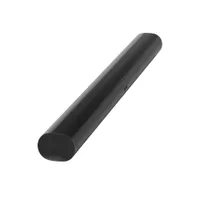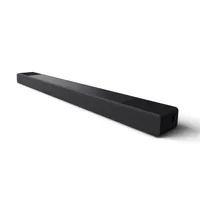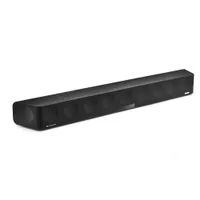TechRadar Verdict
We wish the Devialet Dione provided HDMI passthrough and remote control for its high price, but its genius rotating center channel together with its irresistibly good, bass-rich sound still make it a seriously impressive soundbar for anyone who wants a complete home theater system in a single unit.
Pros
- +
Excellent, bass-rich sound quality
- +
Elegant but practical design
- +
Great for wall mounting or flat placement
Cons
- -
No rear sound
- -
No DTS:X support
- -
No HDMI passthrough
Why you can trust TechRadar
Devialet Dione: Two-minute review
As soon as you look at the Devialet Dione you know it’s no ordinary soundbar. The appearance of a perfect sphere sitting proudly at the heart of a gracefully created valley in the Dione’s middle is like no other soundbar design we’ve seen.
The sultry sculpting isn’t just for show, either. You can actually rotate the center channel ‘Orb’ around in its mount so that the Dione can be either mounted vertically on a wall or sat on a TV stand without sound quality being affected. It's a new one on us, and we couldn't stop playing with it throughout our Devialet Dione review…
Sound is produced via 950W of claimed power pumping through a 5.1.2 channel configuration that includes a pair of up-firing speakers to support the Dione’s Dolby Atmos decoding.
Despite being Devialet’s debut soundbar, the Dione uses this power and channel count to spectacular effect, producing a massive but also beautifully constructed and balanced soundstage underpinned by arguably the finest bass performance we’ve heard from a soundbar that doesn’t deploy an external subwoofer.
We’d have liked to find an HDMI passthrough option for the Devialet Dione’s money, and having to use a mobile phone to control it rather than a normal remote takes a little getting used to. Also, there's simply no option for rear speakers at all, so if you want that, you should consider a Sonos Arc package, or something like the Samsung HW-Q990B that gives you everything in one bundle.
As a single-box sound solution, though, the Dione’s combination of clever functionality and rip-roaring sound ensure put it up there with the very best soundbars available today.
Devialet Dione review: Price and release date
- Released in April 2022
- Official price $2,400 / £1,990 / AU$3,990
The Devialet Dione is pitched very much at the high end of the soundbar market. Even Samsung’s flagship Q990B soundbar system, with its included three-channel rear speakers and separate subwoofer, costs about a quarter less than the Dione.
Sign up for breaking news, reviews, opinion, top tech deals, and more.
While the Samsung system is first and foremost a home theater system, though, there’s a thriving ‘hi-fi’ market in the soundbar world for systems that are as interested in, and as good at, music as they are movies. This seems to be where the Devialet Dione wants to sit, joined as it is at its price point by such renowned rivals as the Sennheiser Ambeo and various Sonos Arc systems (if you add in the Sonos Sub and rear speakers).
Unlike a Sonos Arc system or the Samsung Q990B, though, the Dione wants to do it all – including subwoofer-rivalling bass – from a single box. Tidy, compact(ish), easy to set up. It's like the Sony HT-A7000 in that way… but for 50% more money.
So there's clearly an established place in the market for the Dione, but it will only truly be at home there if it delivers the sound quality goods.
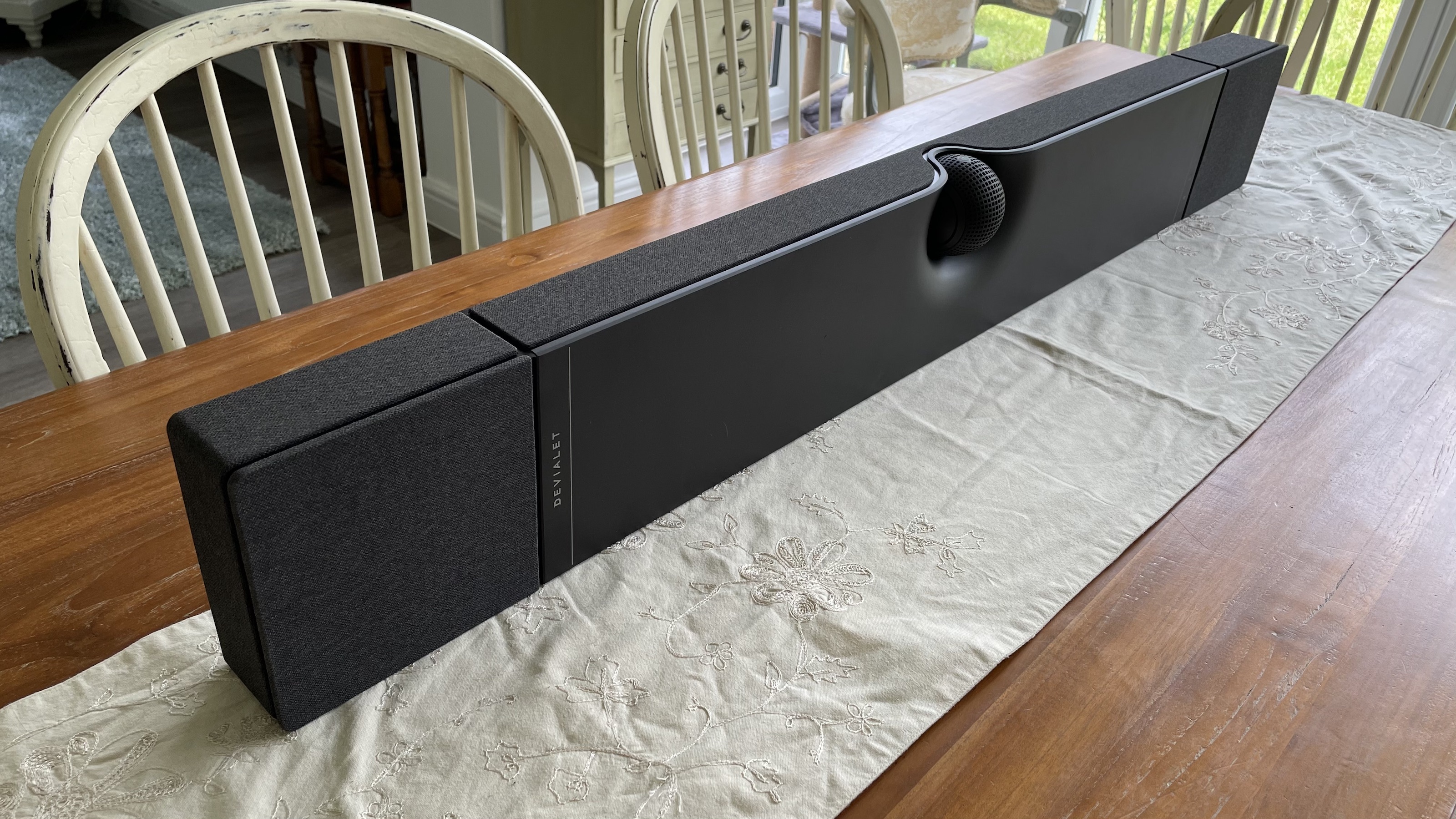
Devialet Dione review: Features
- Rotatable ‘Orb’ center channel
- Designed for wall or desktop mounting
- 5.1.2-channel configuration
The main feature of the Devialet Dione – or at least the one you notice first – is actually its design. Partly for the unique way its single-bar approach looks, which we’ll get into more later, but mostly because of what it does.
The thing is, the unusual spherical speaker that delivers the soundbar’s center channel information can actually be manually rotated round to adjust its direction of sound output. Why might you want to do this? So that you can either sit the Dione horizontally on its wide, flat edge underneath a TV, or hang it up with its wide, flat edge resting against the wall and still have the center sphere firing out its sound in the correct orientation in both configurations.
A built in gyroscope ensures the Dione always knows whether it’s hung up or laid flat, so that it can adjust which channels of sound are being output by the other drivers. So the front drivers when the Dione is laying flat become the upfirers when it’s hanging on a wall, and vice versa.
It’s all so cool, honestly, that a certain type of AV geek will likely be unable to resist rotating the center channel Orb around and back again whenever they have visitors round, just because they can.
The spherical design of the center speaker is intended to help disperse its sound over a wider area than such a small driver would normally manage, while also removing the potential for coloration you can get with straight-edged speakers.
The Dione fits a total of 17 speakers into its reasonably compact form, including nine full range aluminium drivers and a seriously eye-catching eight long-throw bass drivers. This suggests that Devialet is taking low frequencies very seriously indeed with its debut soundbar (it claims to be able to get as low as 24Hz), boding well for its home theater credentials.
As you would expect of a such an expensive soundbar, the Dione supports playback of Dolby Atmos soundtracks. It can also, of course, revert to stereo or even mono for music or old movie soundtracks – though Devialet has developed a SPACE processing system that can upscale low-channel sources to take advantage of the Dione’s full 5.1.2 channel count.
There’s no support for DTS:X, though. DTS is taken in as PCM by the Dione, with the SPACE system then applied to it. Devialet has told us that it could add DTS in the future, in a technological sense, but not to expect it any time soon, if it happens at all.
The Dione’s connections include just a single HDMI, so there’s no possibility of looping HDMI sources through it. Instead you’re limited to using HDMI’s eARC/ARC feature to pass Dolby Atmos and other sound formats through compatible TVs to the soundbar. This is fine in principle, but picture/audio sync issues remain quite common with ARC. The audio delay adjustments found in TVs and some source equipment can often solve such issues if you have them, but a loopthrough on the Dione would have been a welcome back up – especially since it means you don't lose the use of an HDMI port for video sources.
The Dione includes both Wi-Fi and Bluetooth 5.0 connectivity, though, and is compatible with AirPlay 2 and Spotify Connect. The AirPlay 2 system can be used, too, to partner the Dione with Devialet’s Phantom speakers as part of a multi-room installation… or with any other AirPlay 2 speakers, of course.
The Dione provides an excellent autocalibration system that uses input from no less than four built in mics doing to adjust the sound to take into account your specific room conditions.
One final thing to note is that, very unusually, the Dione doesn’t ship with a remote control. Instead you have to control it via the HDMI CEC system and your TV’s remote or, more effectively, via a Devialet app. It's like Sonos' soundbars, in this way.
This app isn’t as straightforward as just picking up a dedicated handset, but it’s easy enough to find your way round with a little practice. It also provides some quite useful information on the exact audio format the Dione is receiving at any given moment.
Devialet sells distinctive-looking ‘Phantom’ remote controls you can buy as an option for the Dione, but most people will probably not feel the need.

Devialet Dione review: Sound Quality
- Remarkable bass performance
- Excellent staging of movies and music
- No real sense of rear channel sound
Since there’s precious little negative to say about the Dione's sound, let’s get its main limitation out of the way first: its single-unit design doesn’t conjure up any real sense of rear channel sound. It does produce plenty of room-filling forward impact, so you still feel involved in a good film mix, but that immersion doesn’t extend to the accurate placement of a multi-channel mix’s rear channel elements.
This, though, is pretty much inevitable with a single bar solution; it’s not as if the Dione is somehow a failure in this regard by single-unit standards. It’s really just a compromise anyone who wants the tidiness of a single-unit soundbar solution needs to accept.
With that formality out of the way, let’s move swiftly on to why the Devialet Dione rocks, starting with the fact that its bass performance is ridiculous. The presence, responsiveness, clarity and raw depth of its low frequency sound is arguably the best we’ve heard from a single-bar solution. The Dione even manages to make the bass sound non-directional, as you would expect to hear with systems that use external subwoofer units.
The bass doesn’t succumb to buzzing, drop out or crackling under even the most extreme assault from notoriously bass-heavy movies, either. And despite how rich and involved the bass sounds, it never overwhelms the rest of the mix.
It should be said that the Dione’s stellar bass doesn’t really start to sing unless you’ve got the volume turned up pretty high. But running a good soundbar loud is just common sense so far as we’re concerned.
The fact that the Dione’s monster bass doesn’t overwhelm the rest of the soundstage is a testament to the quality of its other drivers. The Orb center channel is particularly striking. Concerns that it might be too small to keep up with the other speakers prove unfounded, as it manages to simultaneously lock clean, typically convincing dialog to the onscreen action while also spreading more ambient center channel effects wide enough to ensure that they join in convincingly with its left and right channel information.
The Orb lifts the dialog slightly too, to place it on the screen where the pictures it's accompanying reside, and provides a great sense of precision with other placement effects too.
The left and right speakers and front side speakers both expand the soundstage a serious distance to left and right, while also pushing things forward enough to give you a sense of effects coming from the side of you. All of these channels link together seamlessly, and all of the effects they create, be they ambient, specific placement or transitional, are handled with conviction and accuracy.
The Dione’s sound stage isn’t restricted to a horizontal dimension, either. The upfiring speakers are powerful and focussed enough – regardless of whether you’re using the soundbar on a desktop or a wall – to create a genuine sense of height to a Dolby Atmos mix. What’s more, even though there are only two up-firing speakers (as usual with Dolby Atmos soundbars) these speakers manage to deliver a surprisingly wide splay to their height effects, avoiding any ‘funnelling’ effects.
It’s important to state here that during our tests, the Devialet Dione’s performance was transformed in terms of how well all of its various elements harmonized together by running its built-in calibration system.
The Dione has plenty of power to go with its precision, enabling the sound to fill your room and give you a genuinely cinematic experience with film soundtracks. Yet even towards the top of its volume potential the sound stage retains its balance, poise and clarity, rather than starting to sound forced or brittle.
The only exceptions to this are that the Orb can sound a touch thin with exceptionally shrill sounds, and occasionally gunfire, punches and such like can land slightly softly if they’re part of a very dense soundtrack moment.
As hoped, while the Dione does much better with film soundtracks than the vast majority of single-unit soundbars, it also transforms into a superb music player.
Running it in its Music mode, which preserves the original (typically stereo) channel count of the music you’re listening to, music of all types sounds authentic, detailed, rich, warm and best of all staged with a true hi-fi sensibility and musicality. There’s none of the vulgarity, lack of cohesion and excessive, forced dynamism that you quite commonly get with soundbars that excel with film soundtracks.
Devialet’s SPACE mode is an interesting option for music, though not consistent enough to class as an unqualified success. Relatively sparse tracks, especially if they’re heavy on bass, can benefit quite convincingly from the extra sense of scale and dynamic range the SPACE mode introduces as it adds an extra sense of sophistication to such tracks without the results sounding forced or incoherent.
With denser, heavily produced pop, layered guitar tracks or songs headed up by dominant vocals, though, the SPACE mode can become unnatural and awkward. But if you’re finding that happening with a particular song or album, you can simply set the Dione to its consistently lovely performance in Music mode.

Devialet Dione review: Design
- Unique center speaker ‘Orb’
- Single-bar solution
- 5.1.2-channel configuration
The Devialet Dione’s design is a one off in multiple ways. For starters, there’s the appearance at its heart of a perfect sphere nestled within a dramatic but elegantly crafted ‘trough’. We’ve never seen a center channel speaker like this before.
What’s more, as discussed earlier the ‘Orb’ center speaker can uniquely be rotated round in its robust mount so that it can adapt its output to either wall or desktop mounting.
Its build quality is robust to say the least, and its finish is a lovely combination of smooth, matt black and felt speaker covers. The soundbar looks cool with the speaker covers removed too, if you don’t have potential driver-poking children’s fingers to worry about.
There’s a cute roster of touch-sensitive buttons on the Dione’s top/front, and the height/depth is impressively slim for such a powerful performer. A fact that really emphasises the quality of the system’s driver design.
Full dimensions are 1200 x 77 x 165mm / 47.2 x 3 x 6.5 inches (w x h x d) when using it in its desktop configuration (obviously you need to flip the height and depth measurements when wall hanging). That's still quite a lot more volume than the Sonos Arc… or almost any other soundbar, admittedly. For the sound it puts out, it's pretty compact, but you should still make sure you have the space on your TV stand.
Devialet Dione Review: Value
- Very high-end in the market
- Innovate design and features for the money
- Sound competes with premium rivals
The Devialet Dione is very much at the premium end of the single-unit soundbar market. The innovations it introduces to deliver the maximum audio impact and design flexibility out of its impressively well built and compact form, though, immediately start to justify its price. And that justification continues with its sound quality, as it combines an outstandingly detailed and powerful film soundtrack performance with a lovely blend of power and staging for stereo music.
It may not be a bargain overall, but wouldn't argue it's not value for money for those who want its mix of compactness and audio power.
If this Devialet Dione review made you think that you’re more interested in a full surround sound Dolby Atmos experience than you are in keeping speaker clutter to a minimum, Samsung’s outstanding Q990B soundbar system delivers an external sub, wireless rears and a genuine 11.1.4 channel count for a lot less than the Dione. Though while the Samsung is fantastic for films, it’s not as assured with music.
Should I buy the Devialet Dione?
If you want a single-unit soundbar rather than the clutter of a system with multiple separate speakers, the Devialet Dione is absolutely up there with the best. In fact, it’s arguably a uniquely good option for anyone looking for a wall hanging option – and it’s definitely a uniquely good option for anyone looking for a soundbar that may need to switch between vertical and horizontal stances from time to time.
The Dione is also one of an actually pretty small group of soundbars that excels with music as much as movies, if you want a top-class all-rounder.
The only reason not to buy a Dione – assuming you’re able to afford one – is if you want a true surround sound system with included rear speakers, or perhaps if you simply need HDMI passthrough, or are hardcore for DTS:X. But we'd encourage most people not to be put off by those omissions.
Buy it if…
You want huge home theater sound from a single box
Don't want to wrestle with rear speakers and a subwoofer? This thing is like an IMAX sound system when through a shrink ray, into a single plug-and-play box.
You want to play music as well as movies
The Dione manages to deliver both a cinematic sensibility with films and a hi-fi sensibility with music. Such sound quality flexibility is rare in the soundbar world.
You want to wall mount your soundbar
While it works superbly in a regular desktop configuration, its innovative design, with the rotating ‘Orb’ center speaker, makes it arguably uniquely effective as a wall-hanging soundbar.
Don't buy if…
You're on a budget
Costing as much as a pretty high-end TV, the Dione is very much a premium product that’s far removed from even the rich mid-range, let alone the more budget end. If you can take a separate subwoofer, you can get excellent sound for half the price.
You want a full surround-sound experience
As usual with a single-unit soundbar, you only really get to experience the front half of surround sound movie and music mixes.
Also consider
Sonos Arc
This is basically the sub-$1000/£1000 equivalent of the Dione. It provides good bass and excellent positional sound from a single bar. Like the Dione, it's excellent with music too. And you can add a Sonos Sub and wireless rear speakers in the future if you want to upgrade.
Sony HT-A7000
Sony's single-unit soundbar is really geared towards impressive Dolby Atmos height and 3D effects, and it's the best in its price range for packing that, plus great home theater bass, into one box. It sits between the Sonos Arc and the Dione for price, but it has something they don't have: 4K HDMI 2.1 passthrough.
Sennheiser Ambeo
For the Devialet Dione’s kind of money, its main rival is the Sennheiser Ambeo. This chunkily designed beast costs even more, but it adds 4K HDMI passthrough and DTS:X decoding to its spec sheet, and pumps out a hugely powerful, well-directed sound with Dolby Atmos sources.
- First reviewed: June 2022
- How we test: TechRadar's review guarantee

John has been writing about home entertainment technology for more than two decades - an especially impressive feat considering he still claims to only be 35 years old (yeah, right). In that time he’s reviewed hundreds if not thousands of TVs, projectors and speakers, and spent frankly far too long sitting by himself in a dark room.
